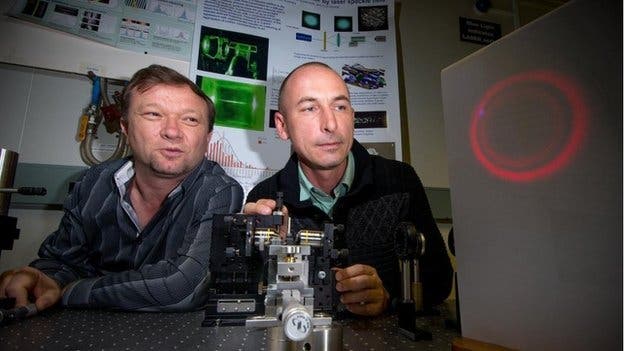A team of scientists has managed to develop a tractor beam which can pull and push objects over 20 cm – 100 times more than previous records. There are a myriad of potential applications for this kind of research, including studying atmospheric pollutants or retrieving delicate particles of material for examination.

Drs Shvedov (L) and Hnatovsky used a doughnut-shaped laser beam to push and pull small glass spheres
“Recent advances in lightwave technology have already led to small-scale experimental demonstrations of tractor beams. However, the realization of long-range tractor beams has not gone beyond the realm of theoretical investigations”, researchers write in their paper.
Until recent years, tractor beams have been more a sci-fi fascination than an actual preoccupation of engineers. But things have changed, and tractor beams have steadily moved from books and comic books to labs. In 2011, we were telling you about NASA researching tractor beams, and earlier this year, about a team which successfully developed an effective water tractor beam.
Previous devices used the impact energy of photon beams to push objects forth; but this new machine uses an entirely different technology – it uses the energy of the laser heating up the particles and the air around them, creating a thermal tunnel which results in the object moving. To this end, they used a so-called hollow laser beam in a laboratory at the Australian National University (ANU) in Canberra. As you can probably guess, the laser is bright on its edges and dark in its center.
The energy from the laser hits the particle, travels along its surface and is absorbed, creating hotspots. Air particles colliding with the hotspots heat up and shoot away from the surface, pushing the particles forth. The objects they manipulated were tiny glass spheres with the diameter of about a fifth of a millimeter. However, the proof of concept was successful, and it showed that the method can definitely be successful. To make it even more interesting, the beam works both way.
“We can move smoothly from one polarisation to another and thereby stop the particle or reverse its direction at will,” said co-author Dr Cyril Hnatovsky from ANU.
They manipulated the objects over distances of 20 cm – the previous record was around 0.2 cm. However, they claim they could have gone way beyond that. Researchers also claim the effect can be easily scaled.
“Because lasers retain their beam quality for such long distances, this could work over metres. Our lab just was not big enough to show it,” said co-author Dr Vladlen Shvedov, also from ANU.
Journal Reference: Vladlen Shvedov, Arthur R. Davoyan, Cyril Hnatovsky, Nader Engheta & Wieslaw Krolikowski. A long-range polarization-controlled optical tractor beam. Nature Photonics (2014) doi:10.1038/nphoton.2014.242








